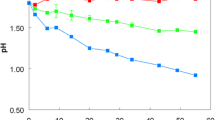Abstract
Clostridium cochlearium could be reproducibly enriched in an L-aspartate- and L-glutamate-limited, anaerobic chemostat inoculated with anaerobic sludge. L-glutamate, L-glutamine and L-histidine were the only fermentable substrates. Less specialised clostridia of the C. tetanomorphum type could only be isolated from batch enrichments with L-glutamate and L-aspartate as energy sources. Competition experiments with C. cochlearium and C. tetanomorphum in a L-glutamate-limited chemostat resulted in the selective elimination of the latter species. Addition of glucose to the medium resulted in coexistence of both species. The molar growth yields for L-glutamate at different dilution rates at 30°C were determined for both species. The maximum specific growth rates on L-glutamate were 0.55 h-1 for C. cochlearium and 0.35 h-1 for C. tetanomorphum.
Similar content being viewed by others
References
Barker, H. A.: On the fermentation of glutamic acid. Enzymologia 2, 175–183 (1937)
Barker, H. A.: The use of glutamic acid for the isolation and identification of Clostridium cochlearium and Cl. tetanomorphum. Arch. Mikrobiol. 10, 375–385 (1939)
Barker, H. A.: Fermentations of nitrogenous organic compounds. In: The Bacteria, Vol. II: Metabolism (I.C. Gunsalus, R. Y. Stanier, eds.), pp. 151–207 New York-London: Academic Press 1961
Bernt, E., Bergmeyer, H. U.: L-Glutamat. Bestimmung mit Glutamat-Dehydrogenase. In: Methoden der enzymatischen Analyse (H. U. Bergmeyer, ed.), 2nd ed., pp. 1659–1663. Weinheim: Verlag Chemie 1970
Holdeman, L. V., Cato, E. D., Moore, W. E. C., eds.: Anaerobe laboratory manual, 4th ed. Blacksburg: V. P. I. Anaerobe Laboratory, Virginia Polytechnic Institute and State University 1977
Laanbroek, H. J., Kingma, W., Veldkamp, H.: Isolation of an aspartate-fermenting, free-living Campylobacter spec. FEMS Lett 1, 99–102 (1977)
Laanbroek, H. J., Stal, L. J., Veldkamp, H.: Utilization of hydrogen and formate by Campylobacter spec. under aerobic and anaerobic conditions. Arch. Microbiol. 119, 99–102 (1978)
Smith, L. D. S., Hobbs, G.: Genus Clostridium. In: Bergey's manual of determinative bacteriology (R. E. Buchanan, N. E. Gibbons, eds.), 8th ed., pp. 551–572. Baltimore: Williams and Wilkins 1974
Spray, R. S., McClung, L. S., McCoy, E.: Genus Clostridium. In: Bergey's manual of determinative bacteriology (R. S. Breed, E. G. D. Murray, N. R. Smith, eds.), 7th ed., pp. 634–694. Baltimore: Williams and Wilkins 1957
Vishniac, W., Santer, M.: The thiobacilli. Bacteriol. Rev. 21, 195–213 (1957)
Author information
Authors and Affiliations
Rights and permissions
About this article
Cite this article
Laanbroek, H.J., Smit, A.J., Nulend, G.K. et al. Competition for L-glutamate between specialised and versatile Clostridium species. Arch. Microbiol. 120, 61–66 (1979). https://doi.org/10.1007/BF00413275
Received:
Issue Date:
DOI: https://doi.org/10.1007/BF00413275




